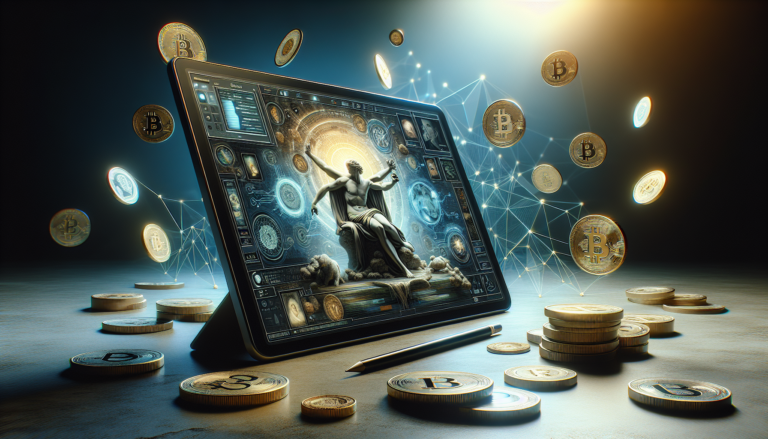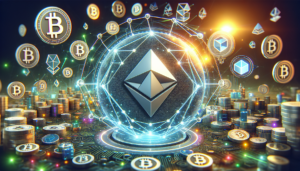In recent years, the world of digital assets has seen a significant surge in interest and innovation, with Non-Fungible Tokens (NFTs) taking center stage. NFTs have revolutionized the way we perceive and value digital content, opening up new opportunities for creators, collectors, and investors alike. This article delves into the concept of NFT crypto, exploring its definition, how it works, and its potential impact on various industries.
What Is NFT Crypto?
Definition and Basic Concept
NFT crypto, or Non-Fungible Tokens, are unique digital assets that represent ownership or proof of authenticity of a specific item or piece of content. Unlike traditional cryptocurrencies, such as Bitcoin or Ethereum, which are fungible (interchangeable), each NFT is one-of-a-kind and cannot be replicated or divided. This uniqueness is what gives NFTs their value and makes them highly sought-after in the digital world.
The concept of NFTs is built on blockchain technology, which serves as a decentralized ledger for recording and verifying transactions. By leveraging the security and transparency of blockchain, NFTs provide a tamper-proof way to establish ownership and provenance of digital assets. This has opened up new possibilities for creators to monetize their work and for collectors to own verifiable, authentic pieces of digital content.
How NFTs Differ from Cryptocurrencies
While NFTs and cryptocurrencies both utilize blockchain technology, there are significant differences between the two. Cryptocurrencies, such as Bitcoin, are designed to be fungible, meaning that each unit is interchangeable with another. In contrast, NFTs are non-fungible, with each token representing a unique asset.
Another key difference lies in their purpose. Cryptocurrencies are primarily used as a means of exchange or store of value, while NFTs are used to represent ownership of specific digital assets, such as artwork, music, or virtual real estate. This distinction has led to the emergence of new markets and ecosystems centered around the creation, trade, and collection of NFTs.
How NFTs Work
Blockchain Technology and NFTs
The foundation of NFTs lies in blockchain technology, which provides a secure and transparent way to record and verify transactions. When an NFT is created, it is minted on a blockchain, such as Ethereum, which assigns it a unique identifier and stores the associated metadata. This metadata can include information about the asset’s creator, ownership history, and any additional details that add value or context to the NFT.
The use of blockchain ensures that the ownership and provenance of NFTs can be easily tracked and verified. Each transaction involving an NFT is recorded on the blockchain, creating an immutable record of its history. This transparency and security have been crucial in establishing trust and value in the NFT market.
Smart Contracts and NFT Transactions
Smart contracts play a vital role in the creation and exchange of NFTs. A smart contract is a self-executing contract with the terms of the agreement directly written into lines of code. When an NFT is minted, a smart contract is created that defines the rules and conditions surrounding its ownership and transfer.
When an NFT is bought or sold, the smart contract automatically executes the transaction, ensuring that the ownership is transferred to the new owner and that the seller receives the agreed-upon payment. This automation eliminates the need for intermediaries and provides a seamless and secure way to conduct NFT transactions.
Storing NFTs in Digital Wallets
Once an NFT is acquired, it is stored in a digital wallet, similar to how cryptocurrencies are stored. These wallets are designed to securely hold and manage digital assets, including NFTs. The ownership of an NFT is tied to the wallet address, and the owner has full control over their assets.
Digital wallets come in various forms, such as software wallets that can be installed on a computer or mobile device, or hardware wallets that provide an additional layer of security by storing the private keys offline. It is crucial for NFT owners to choose a reputable and secure wallet provider to ensure the safety of their digital assets.
Use Cases of NFTs
NFTs in Art and Music
One of the most prominent use cases for NFTs has been in the art and music industries. Artists and musicians have embraced NFTs as a way to create unique, verifiable digital works and monetize their creations directly with their fans and collectors.
In the art world, NFTs have enabled artists to sell digital versions of their artwork, often accompanied by physical prints or exclusive experiences. This has opened up new revenue streams for artists and has given collectors the opportunity to own one-of-a-kind digital pieces.
Similarly, musicians have used NFTs to release limited-edition albums, concert tickets, and exclusive merchandise. By offering unique, verifiable experiences and collectibles, artists can forge stronger connections with their fans and create new sources of income.
NFTs in Gaming and Virtual Real Estate
The gaming industry has also seen significant adoption of NFTs, with in-game items, characters, and virtual real estate being tokenized and traded as NFTs. This has created new opportunities for players to own and trade unique digital assets, adding value and scarcity to virtual worlds.
Virtual real estate has emerged as another exciting use case for NFTs. Platforms like Decentraland and The Sandbox allow users to purchase, develop, and monetize virtual land parcels. These virtual properties can be used for a variety of purposes, such as hosting events, displaying art, or creating interactive experiences.
The integration of NFTs in gaming and virtual worlds has the potential to revolutionize the way we interact with and value digital assets. As these ecosystems continue to grow and evolve, NFTs will likely play a central role in shaping the future of virtual ownership and experiences.
NFT Marketplaces
Popular NFT Marketplaces
As the NFT market has grown, numerous marketplaces have emerged to facilitate the buying and selling of these digital assets. Some of the most popular NFT marketplaces include:
- OpenSea: One of the largest and most diverse NFT marketplaces, offering a wide range of digital assets across various categories.
- Rarible: A community-focused marketplace that allows users to create, buy, and sell NFTs across multiple blockchain networks.
- Foundation: A curated platform that focuses on high-quality digital art and has hosted some of the most high-profile NFT auctions.
These marketplaces provide a user-friendly interface for browsing, buying, and selling NFTs, as well as tools for creators to mint and promote their digital assets. As the NFT ecosystem continues to evolve, new marketplaces are likely to emerge, catering to specific niches and offering unique features and services.
How to Buy and Sell NFTs
To participate in the NFT market, users need to follow a few key steps:
- Set up a digital wallet: Choose a compatible wallet that supports the blockchain network on which the desired NFTs are built (e.g., Ethereum, Binance Smart Chain).
- Fund the wallet: Purchase the necessary cryptocurrency (such as Ethereum) to cover the cost of the NFT and any associated transaction fees (gas fees).
- Browse and select an NFT: Visit an NFT marketplace, explore the available assets, and select the desired NFT.
- Place a bid or buy outright: Depending on the auction format, place a bid or purchase the NFT at the listed price.
- Confirm the transaction: Follow the prompts to confirm the transaction and wait for the blockchain network to validate the purchase.
Once the transaction is complete, the NFT will be transferred to the buyer’s wallet, and the ownership will be recorded on the blockchain. To sell an NFT, the process is similar, with the owner listing the asset for sale on a marketplace and waiting for a buyer to purchase or place a winning bid.
Challenges and Concerns with NFTs
Environmental Impact of NFTs
One of the main concerns surrounding NFTs is their potential environmental impact. The creation, transfer, and storage of NFTs rely on blockchain technology, which often requires significant computational power and energy consumption. This has led to concerns about the carbon footprint associated with NFT transactions.
To address these concerns, some blockchain networks, such as Ethereum, are transitioning to more energy-efficient consensus mechanisms (like Proof-of-Stake) to reduce their environmental impact. Additionally, some NFT platforms are exploring the use of carbon offsets or supporting renewable energy projects to mitigate their environmental footprint.
Copyright and Intellectual Property Issues
Another challenge in the NFT space is the potential for copyright and intellectual property infringement. As the NFT market has grown, there have been instances of individuals minting and selling NFTs of artwork or content that they do not own the rights to.
To combat these issues, NFT marketplaces and creators are working to implement stronger verification processes and are encouraging the use of original, authenticated content. However, the decentralized nature of blockchain technology makes it difficult to fully prevent unauthorized use or replication of digital assets.
As the NFT ecosystem matures, it will be crucial for stakeholders to collaborate on developing standards and best practices to protect intellectual property rights and ensure the legitimacy of the assets being traded.
Investing in NFTs
Potential for Profit and Risks
The NFT market has seen substantial growth and media attention, with some high-profile sales reaching millions of dollars. This has attracted investors and speculators looking to capitalize on the potential for profit in this new asset class.
However, investing in NFTs comes with significant risks. The value of NFTs is primarily driven by market demand, hype, and subjective factors, making it difficult to accurately predict their long-term value. Additionally, the NFT market is highly speculative and prone to sudden price fluctuations, which can result in substantial losses for investors.
Speculative Nature of the NFT Market
It is essential for potential investors to understand the speculative nature of the NFT market. Many NFTs derive their value from factors such as scarcity, cultural significance, and community engagement, rather than inherent utility or cash flows.
The NFT market has also been subject to hype cycles and market manipulation, with some projects experiencing rapid price appreciation followed by sharp declines. Investors should approach NFTs with caution and conduct thorough research before investing, understanding the risks involved and only investing what they can afford to lose.
As with any speculative investment, diversification and risk management strategies are crucial when engaging with the NFT market. It is also important to keep in mind that the regulatory landscape surrounding NFTs is still evolving, and future regulations may impact the market in unpredictable ways.
The Future of NFTs
Interoperability and Technological Advancements
As the NFT ecosystem continues to develop, there is a growing focus on improving interoperability between different blockchain networks and NFT platforms. This would allow for seamless transfer and use of NFTs across various ecosystems, increasing their utility and value.
Technological advancements, such as the development of Layer 2 scaling solutions and the integration of NFTs with virtual and augmented reality, are also expected to play a significant role in shaping the future of NFTs. These innovations could unlock new use cases and experiences, further expanding the potential of NFTs.
Regulatory Considerations
As NFTs gain mainstream adoption and attract the attention of regulators, it is likely that we will see increased scrutiny and the development of regulatory frameworks for the NFT market. This could include rules around taxation, consumer protection, and anti-money laundering measures.
The regulatory landscape will play a crucial role in shaping the future growth and legitimacy of the NFT market. Clear and well-defined regulations could provide greater certainty and protection for investors and creators, while also mitigating potential risks associated with the technology.
As the NFT space continues to evolve, it will be important for stakeholders to engage with regulators and contribute to the development of a balanced and effective regulatory environment that fosters innovation while protecting the interests of all participants.
In conclusion, NFT crypto represents a fascinating and rapidly evolving area of the digital asset landscape. With their ability to establish unique ownership and provenance of digital content, NFTs have the potential to revolutionize industries ranging from art and music to gaming and virtual real estate. As the technology and ecosystem mature, it will be exciting to see how NFTs continue to shape the future of digital ownership and value creation.
See also:






